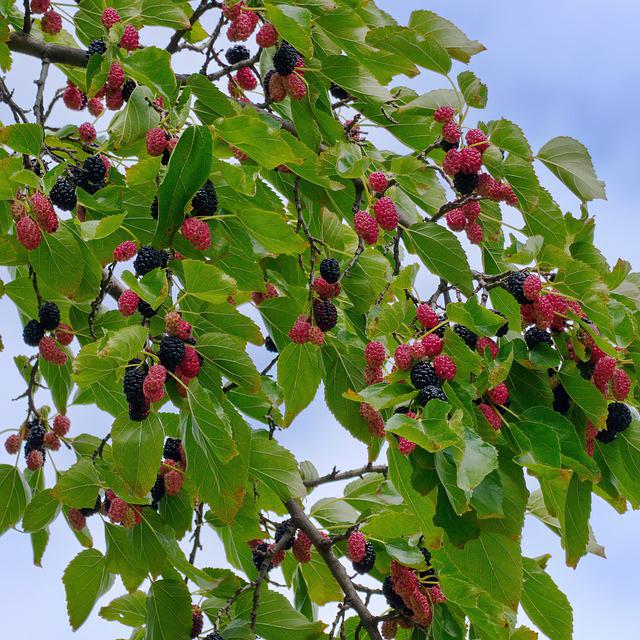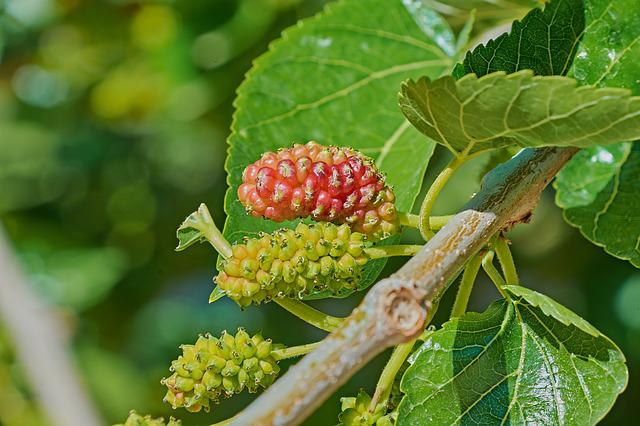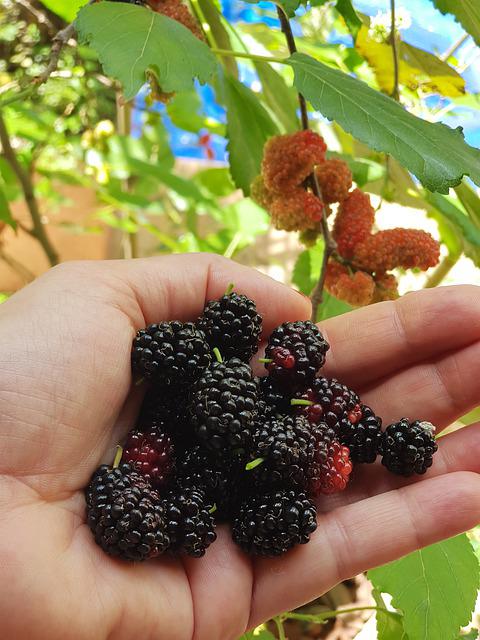Do All Mulberry Trees Bear Fruit? A Complete Guide to Identifying and Harvesting Your Mulberry

There’s a fruitless mulberry tree called Morus alba ‘Fruitless.’ They look just as lovely as varieties with fruit, but they don’t make a mess or spread as quickly. A mulberry tree that doesn’t bear fruit is a great choice for a medium-sized to a large shade tree in a home garden. Mulberry can bear sweet and tasty fruit. However, some factors make Mulberry stop from bearing fruits.
Table of Contents
Fruitless Mulberry
Fruitless mulberries don’t have very showy flowers, but they have clusters of light-green flowers in early spring. Their beauty comes from glossy green leaves on green or grayish-white branches. Each cultivar has a different leaf shape. It grows from 6 to 18 meters tall and has a dense canopy as wide as 45 feet. In the summer, this handsome tree has dark green leaves that turn yellow before falling off.
History
Mulberry trees, a deciduous tree, can be found in North America and Asia. M. alba and its cultivars are the most widely planted Mulberry in the United States. ‘Silkworms eat this plant, which is why it was once used to raise the worms for making silk. Since fruiting silkworms cannot be kept or shipped for long periods in America, their fruiting varieties have fallen out of use. While they can grow quite large, mulberry trees tend to have a short, stout trunk and a wide crown of branches when they’re exposed to the elements. At the base of an old mulberry tree, there are usually dormant buds that can be reactivated. As long as the roots are viable, trees that have been blown down and are still able to grow and produce fruit can continue for many years.
Varieties
“Kingan” has big, dark-green leaves in the shape of a heart, while “Stribling, “Mapleleaf,” and “Fruitless” have lobed leaves that look a bit like maple leaves. Before they fall off in the fall, the leaves turn different shades of yellow.
Mulberries that don’t have any fruit can grow as single-trunk, multi-trunk, standard, weeping, or dwarf trees. Their drooping branches will eventually need to be cut back in the winter so that cars and people can get by. Mature standard trees have 30 to 45-foot-wide canopies that spread out in different directions or have rounded shapes. The ‘Urbana’ weeping cultivar grows up to 20 feet tall. Weeping’ Chaparral,’ which grows 12 to 15 feet tall and up to 20 feet wide, brings the beauty of a weeping willow to smaller yards and gardens.
Landscape Use
Mulberry trees can be grown in a wide range of soil conditions and areas with long summers, such as southern California’s inland valley and desert regions, as long as they are protected from the wind. They can withstand the pollution that is common in urban and suburban areas. Mulberry trees produce male and female flowers in 1-inch clusters on the same tree or separate trees during the spring and early summer. The flowers and fruit can be a nuisance to clean up in the fruiting varieties. Fruits can be eaten, but they can also damage surfaces.
Care Tips
Both white and black, Mulberries can be grown throughout the United States, but only in warm climates. Stagger new plants carefully because their crowns grow quickly and are prone to top-heaviness. This is prone to snapping in high winds, especially the young trunks. They can be grown in nearly any soil type, in either direct sunlight or light shade. On the other hand, trees thrive in soil that is deep, moist, but well-drained.
The trees will be able to withstand periods of drought once they have established themselves. It’s best to do the pruning in the dead of winter after the leaves have all fallen. Every few years, it’s normal to have to cut back on the lower branches. A few years into the tree’s life, it’s best to prune the branches back and shorten them, so they don’t get too long and droopy.

Propagation
Depending on the species, it is possible to grow these trees from young or ripened wood cuttings. A cold frame or other enclosure can be used to keep the cuttings safe. For propagation, grafting or seeds can also be employed.
Pruning
Pruning mature trees is rarely necessary, but young trees may need to be shaped and drooping branches removed or shortened. It is best to prune mulberries in winter after the leaves have fallen when they are dormant and dormant. Any time of year is good to remove diseased or broken branches.
Why Are Fruit-Bearing Mulberry Trees No Longer Bearing Fruit?
Frost Pocket
There might be a frost pocket where Mulberry moved. The area could be lower than the areas around it, so cold air stays longer. Frost can be tricky and sneaky because we don’t always pay close attention early in the season. You might see flowers, but if you cut one open, the ovary inside might be brown and dead.
When frosts start happening in March, look at the grass to see if the area is a frost pocket. If all the grass is white, the frost was pretty hard. When the temperature stays around 32 degrees, look for places where some of the grass is not white, and other parts are. When planting trees or shrubs that bloom in the spring, you should avoid planting them in these white spots.
This year, check the blooms on the tree to make sure they are healthy. Open the flowers up from top to bottom. Look at the ovary, which will become the fruit, at the bottom of the flower. If it’s green, you should be fine.
If it is brown to black, the frost killed the fruit.
Fertilizing
Even when the soil isn’t very good, mulberry trees do well. Mulberry trees grow well and have a lot of fruit along the streets and next to empty homes in Youngstown. So too much fertilizer could cause problems and lead to more growth and less focus on making fruit. You don’t have to put manure in your garden every year.
Conduct a soil test to determine the pH and the amount of nutrients.
Where to Plant Mulberry?
If you want to grow this fruit tree in Florida, choose a spot where it will get a lot of sun. Even though mulberry plants can grow in the wild in the shade of taller trees, it would be best if they could also grow in some shade.
When growing Mulberry at home, it is important to remember that when the berries fall off when ripe, they can stain your driveways, sidewalks, concrete, etc. If you don’t want this plant to stain those, it’s best to plant it away from them.
Here you can order the Mulberry plant to look great in your garden or on your patio. Mulberry trees can grow well in hardy zones 4–9 or even inside with enough light and heat.
References:
Carter, K. (n.d.) Fruitless Mulberry Tree; https://ucanr.edu/sites/urbanhort/files/80182.pdf
Carroll, J. (2021, May 17). StackPath. StackPath; www.gardeningknowhow.com. https://www.gardeningknowhow.com/ornamental/trees/fruitless-mulberry/fruitless-mulberry-trees.htm
Harley, G. (2020, March 13). How To Grow A Mulberry Tree In Florida – Garden Florida. Garden Florida; gardenfl.com. https://gardenfl.com/how-to-grow-a-mulberry-tree-in-florida/
Non-Bearing Mulberry Trees | Home Guides | SF Gate. (2021, July 19). Home Guides | SF Gate; homeguides.sfgate.com. https://homeguides.sfgate.com/nonbearing-mulberry-trees-29508.html
Q&A: Why won’t my mulberry trees produce fruit anymore? | News, Sports, Jobs – The Vindicator. (n.d.). Vindy.Com; www.vindy.com. Retrieved May 10, 2022, from https://www.vindy.com/life/lifestyles/2021/02/qa-why-wont-my-mulberry-trees-produce-fruit-anymore/

